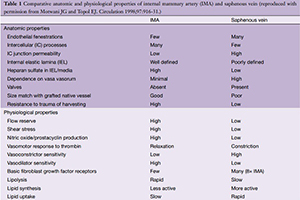Why is the mammary artery so special and what protects it from atherosclerosis?
Abstract
The internal mammary artery (IMA) grafts have been associated with long-term patency and improved survival as compared to saphenous vein grafts (SVGs). Early failure of IMA is attributed to poor surgical technique and less with thrombosis. Similarly, bypass surgery especially with the use of IMA has also been shown to be superior at 1-year as well as over five years compared to percutaneous procedures, including the use of drug-eluting stents for the treatment of coronary artery disease. The superiority of IMAs over SVGs can be attributed to its striking resistance to the development of atherosclerosis. Structurally its endothelial layer shows fewer fenestrations, lower intercellular junction permeability, greater anti-thrombotic molecules such as heparin sulfate and tissue plasminogen activator, and higher endothelial nitric oxide production, which are some of the unique ways that make the IMA impervious to the transfer of lipoproteins, which are responsible for the development of atherosclerosis. A better comprehension of the molecular resistance to the generation of adhesion molecules that are involved in the transfer of inflammatory cells into the arterial wall that also induce smooth muscle cell proliferation is needed. This basic understanding is crucial to championing the use of IMA as the first line of defense for the treatment of coronary artery disease.
Cover






